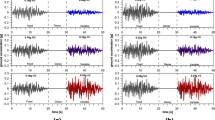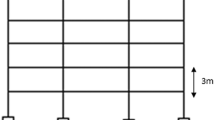Abstract
The current study aims to investigate damage assessment of the RC frames with brick masonry infill (BMI). The effects of near-source ground motions (GMs) are considerably predominant in the seismic response of the structure as related to far-source ground motion due to their forward directivity plus long period. The near-source ground motion is characterized by enormous everlasting ground translation, strong peak ground acceleration (PGA), and a very low-frequency pulse. The Indian codes have not yet incorporated the influence of near-source GM into their design response spectra. Hence, IDA curves that represent ground motion uncertainty have been established for ten near-field ground motion records. Further, the fragility curves have been constructed to envisage progressive damage to the structure. The spectral acceleration-based fragility curves for the ten-story RC frames without BMI, with BMI, and with the open ground story are developed. It is proved that the BMI frame shows better performance during seismic motions. The probability of damage for the collapse prevention state is reduced for frames with BMI, and with open-ground story frames as compared to a frame without BMI.








Similar content being viewed by others
References
Barnaure, M., & Stoica, D. N. (2015). Analysis of masonry infilled RC frame structures under lateral loading. Mathematical Modelling in Civil Engineering, 11(1), 1–11. https://doi.org/10.1515/mmce-2015-0004
Borele, S. V., & Debarati, D. (2015). Damage assessment of structural system using fragility curves. Journal of Civil Engineering and Environmental Technology, 2(11), 72–76.
Cinitha, A., Umesha, P. K., & Iyer, N. R. (2012). Nonlinear static analysis to assess performance and vulnerability of code-conforming RC Buildings. WSEAS Transactions on Applied and Theoretical Mechanics, 7(1), 39–48.
Dhakal, R. P., Singh, S., & Mander, J. B. (2007). Effectiveness of earthquake selection and scaling method in New Zealand. Bulletin of the New Zealand Society for Earthquake Engineering, 40(3), 989–1008.
Dolsek, M., & Fajfar, P. (2008). The effect of masonry infills on seismic response of a four-story reinforced concrete frame - a probabilistic assessment. Engineering Structures, 30(11), 3186–3192.
EI-Dakhalhni, W., Hamid, A. H. & Elgaaly, M. (2004) Strength and stiffness prediction of masonry infill panels. 12th World Conference on Earthquake Engineering, 3089, 1–9.
FEMA 273 (1997). Guidelines for the seismic rehabilitation of buildings. Report No. 273, Federal EmergencyManagement Agency, Washington DC.
FEMA 356 (2000). Prestandard and commentary for seismic rehabilitation of buildings. Washington DC: Applied Technology Council for the Building Seismic Safety Council.
FEMA P695 (2009). Quantification of building seismic performance, Applied Technology Council, California
Haselton, C. B., Baker, J. W., Liel, A. B., & Deierlein, G. G. (2011). Accounting for ground-motion shape characteristics in structural collapse assessment through an adjustment for epsilon. Journal of Structural Engineering, ASCE, 137(3), 332–344.
Inel, M., & Ozmen, H. B. (2006). Effects of plastic hinge properties in nonlinear analysis of reinforced concrete buildings. Journal of Engineering Structures, 281, 494–1502.
IS 456 (2000). Indian Standard, Plain and reinforced concrete, code of practice. New Delhi: Bureau of Indian Standards.
IS (1893). Indian Standard, Criteria for Earthquake Resistant Design of Structures (Part 1), General Provisions and Buildings, (Sixth Revision) (p. 2016). Bureau of Indian Standards, New Dehli.
Karthik Reddy, K. S. K., Veggalam, S., & Somala, S. N. (2022). Spatial variation of structural fragility due to super shear earthquakes. Structures, 44, 389–403. https://doi.org/10.1016/j.istruc.2022.08.025
Kaushik, H. B., Rai, D. C., & Jain, S. K. (2007). Stress-strain characteristics of clay brick masonry under uniaxial compression. Journal of Materials in Civil Engineering, 19, 728–739. https://doi.org/10.1061/(ASCE)0899-1561(2007)19:9(728).
Kaveh, A. (2014). Computational structural analysis and finite element methods (pp. 1–445). Springer Verlag.
Kaveh, A., Javadi, S. M., & Moghanni, R. M. (2021). Optimization-based record selection approach for incremental dynamic analysis and estimation of fragility curves. Scientia Iranica, 28(2), 700–708.
Kaveh, A., Rahami, H., & Shojaei, I. (2020). Swift analysis of civil engineering structures using graph theory methods (pp. 1–311). Cham: Springer.
Kravasilis, T. L., Bazeo, S. N., & Beskos, D. E. (2006). Maximum displacement profiles for performance-based seismic design of plane steel moment resisting frames. Engineering Structures, 28(1), 9–22.
Liu, C., Liu, B., Wang, X., Kong, J., & Gao, Y. (2022). Seismic performance target and fragility of masonry infilled RC frames under in-plane loading. Special Issue Earthquake Engineering and Urban Resilience, Buildings, 12, 1–16. https://doi.org/10.3390/buildings12081175
Luco, N., & Cornell, C. A. (2007). Structure-specific, scalar intensity measures for near-source and ordinary earthquake GMs. Earthquake Spectra, 23(2), 357–392. https://doi.org/10.1193/1.2723158
Madan, A., & Hashmi, A. K. (2014). Analytical prediction of seismic performance of masonry infilled reinforced concrete frames subjected to near-field earthquakes. Journal of Structural Engineering, 134(9), 1569–1581.
Mander, J. B., Priestley, M. J., & Park, R. (1988). Observed stress-strain behaviour of confined concrete. ASCE Journal of Structural Engineering, 114(8), 1827–1849.
Moniri, H. (2017). Evaluation of the seismic performance of reinforced concrete (RC) buildings under near-field earthquakes. International Journal of Advanced Structural Engineering, 9, 13–25.
Mosalam, K. M., & Gunay, S. (2015). Progressive collapse analysis of reinforced concrete frames with unreinforced masonry infill walls considering in-plane /out of plane interaction. Earthquake Spectra, SAGE Journal, 31(2), 921–943. https://doi.org/10.1193/062113eqs165m
Patil, V. S., & Tande, S. N. (2017). Development of seismic fragility curves for mid-rise masonry infilled reinforced concrete building by incremental dynamic analysis. Journal of Structural Engineering, 44(4), 297–306.
PEER (Pacific Earthquake Engineering Research Center), NGA Database-http://peer.berkeley.edu/peer_ground_motion_database
Phadnis, P. P., & Karjinni V. V. (2019a). Effect of infill in composite shear wall RCC building on fragility curve. The Indian Concrete Journal, 57–67.
Phadnis, P. P. (2022) Fragility Analysis for frame with RC and steel-composite shear wall. Resilient Infrastructure, Proceedings of VCDRR Lecture Notes in Civil Engineering, Springer, Singapore.
Phadnis, P. P., & Karjinni, V. V. (2019b). Fragility curves for steel-concrete composite shear wall building with torsional irregularity. Asian Journal of Civil Engineering, Building and Housing, 20(8), 1163–1178. https://doi.org/10.1007/s42107-019-00174-6
Phadnis, P. P., & Karjinni, V. V. (2021). Fragility curves for steel-concrete composite shear wall RCC infill moment resisting frame. Journal of Structural Engineering., 47(6), 453–465.
Raju, R. K., Cinitha, A., & Iyer, N. R. (2012). Seismic performance evaluation of existing RC buildings designed as per past code of practice. Indian Academy of Sciences, 37(2), 281–297.
Ramao, X., Delgado, R., & Costa, A. (2013). Alternative closed-form solutions for mean rate of exceedance of structural limit states. Earthquake Engineering and Structural Dynamics, 42(12), 1827–1845.
Saha, S. K., Reddy, K. S. K., & Somala, S. N. (2022). Assessment of steel frame subjected to simulated directivity earthquakes: the unilaterality of fault normal component at various rupture distances. Journal of Building Engineering, 47, 1–30. https://doi.org/10.1016/j.jobe.2021.103880
Shakib, H., & Pirizadeh, M. (2014). Probabilistic seismic performance assessment of setback buildings under bidirectional excitation. Journal of Structural Engineering. https://doi.org/10.1061/(ASCE)ST.1943-541X.0000835
Smith, B., & Carter, C. (1970). A method of analysis for infilled frames. Proceedings of Institution of Civil Engineers, 44(4), 31–48.
Somala, S. N., Karthik Reddy, K. S. K., & Mangalathu, S. (2022). Diaphragm abutment Californian bridges subjected to UCERF2 rupture scenarios: Complete damage state evolution with improvements to seismic codes. Soil Dynamics and Earthquake Engineering. https://doi.org/10.1016/j.soildyn.2022.107204
Su, R. K. L., & Lee, C. L. (2013). Development of seismic fragility curves for low-rise masonry infilled reinforced concrete buildings by a coefficient-based method. Journal of Earthquake Engineering and Engineering Vibration, 12(2), 319–332.
Vamvatsikos, D., & Cornell, C. A. (2002a). The incremental dynamic analysis and its application to performance-based earthquake engineering. 12th European Conference on Earthquake Engineering, 479, 1–10.
Vamvatsikos, D., & Cornell, C. A. (2002b). Incremental Dynamic Analysis. Earthquake Engineering and Structural Dynamics., 31, 491–514.
Veggalam, S., Karthik Reddy, K. S. K., & Somala, S. N. (2021). Collapse fragility due to near-field directivity GMs: Influence of component, rupture distance, hypocenter location. Structures, 34, 3684–3702. https://doi.org/10.1016/j.istruc.2021.09.096
Funding
The specific funds are not utilized for this research work.
Author information
Authors and Affiliations
Contributions
1. Dr. P.P. Phadnis guided the research work and prepared the manuscript for the submission. 2. Mr. R.M. Desai guided the research work and help to carry out IDA. 3. Dr. S.N. Tande guided the research work. 4. Mr. Pranav Dhumal performed the IDA and fragility analysis.
Corresponding author
Ethics declarations
Conflict of interest
On behalf of all authors, I (the corresponding author) declare that there is no conflict of interest.
Additional information
Publisher's Note
Springer Nature remains neutral with regard to jurisdictional claims in published maps and institutional affiliations.
Rights and permissions
Springer Nature or its licensor (e.g. a society or other partner) holds exclusive rights to this article under a publishing agreement with the author(s) or other rightsholder(s); author self-archiving of the accepted manuscript version of this article is solely governed by the terms of such publishing agreement and applicable law.
About this article
Cite this article
Phadnis, P.P., Desai, R.M., Tande, S.N. et al. Fragility analysis of masonry infill R.C. frame using incremental dynamic approach. Asian J Civ Eng 24, 3375–3386 (2023). https://doi.org/10.1007/s42107-023-00719-w
Received:
Accepted:
Published:
Issue Date:
DOI: https://doi.org/10.1007/s42107-023-00719-w




